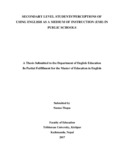Please use this identifier to cite or link to this item:
https://elibrary.tucl.edu.np/handle/123456789/1709| Title: | Secondary Level Student’s Perceptions of Using English as a Medium of Instruction (Emi) In Public Schools |
| Authors: | Thapa, Shusma |
| Keywords: | Students;Perception;English |
| Issue Date: | 2017 |
| Publisher: | Central Department of Education English |
| Abstract: | This research work entitled Secondary Level Students’ Perceptions of Using English as a Medium of Instruction (EMI) in Public Schools has been carried out to find out secondary level students’ perceptions of using EMI in terms of opportunities and challenges in public schools of Tanahun district. I used purposive non random sampling procedure to select thirty secondary level students studying in two public schools of Tanahun district, where EMI has been implemented. A set of questionnaire was used as a tool for data collection. The data obtained through close-ended questionnaire was analyzed statistically and open-ended questionnaire was analyzed descriptively. The study shows that all of the respondents had positive attitude towards EMI that it offers greater opportunity for further study. Almost all of the students (i.e. 96.66%) opined that English provides good career prospects. No availability of English medium textbooks on time and difficulty in using English as the means of classroom interaction with teachers are main challenges related to EMI. Most of the respondents (i.e. 93.33%) opined that interaction between teachers and students should be in English medium as well English medium textbooks and other supportive materials should be available on time. This study consists of five chapters. The first chapter is introductory in nature. It includes background of the study, statement of the problem, objectives of the study, research questions, significance of the study, delimitations of the study and operational definitions of the key terms. The second chapter deals with the review of related theoretical literature, related empirical literature, implications of the study and conceptual framework. Similarly, the third chapter deals with design and method of the study, population, sample and sampling strategy, research tools, sources of data, data collection procedures, data analysis procedures and ethical considerations. Similarly, the fourth chapter presents the analysis of data and interpretation of results. Finally, the fifth chapter includes the findings, conclusion and recommendations of the study. |
| URI: | http://elibrary.tucl.edu.np/handle/123456789/1709 |
| Appears in Collections: | English Language Education |
Files in This Item:
| File | Description | Size | Format | |
|---|---|---|---|---|
| Cover Page(5).pdf | 35.92 kB | Adobe PDF |  View/Open | |
| CHAPTER-1.pdf | 916.7 kB | Adobe PDF |  View/Open |
Items in DSpace are protected by copyright, with all rights reserved, unless otherwise indicated.
